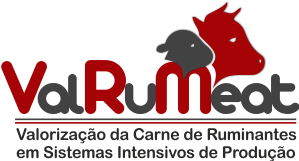MEAT SCIENCE 2019 (in press)
Effects of alfalfa particle size and starch content in diets on feeding behaviour, intake, rumen parameters, animal performance and meat quality of growing lambs.
Francisco, A. E.; M. Janíček, M.; Dentinho, T.; Portugal, P.; Almeida, J.; Alves, S. P.; Fialho L.; Jerónimo, E.; Bessa, R. J. B.; Santos-Silva, J..
ABSTRACT
Thirty-two Merino lambs were used in experiment designed to evaluate the effects of forage particle size and starch level in complete mixed diets, on growth performance, carcass and meat quality traits. All the diets were supplemented with 6% soybean oil and include 40% of alfalfa. The lambs were randomly allocated to eight diets that combined two forms of presentation of alfalfa hay – chopped or ground – with four levels of barley in the diet – 33.0, 21.3, 11.2 and 0%. The lambs were individually housed and stayed on trial during six weeks until slaughter. Feed intake was controlled daily and live weight weekly. Dry matter intake was 17% higher (1,239 vs 1,061 g/day) and average daily weight gain (ADG) was 10.4% higher (328 vs 297 g/day) when forage was grounded. Carcass and meat quality traits were not affected by treatments except carcass weight that was about 6% higher for ground alfalfa (16.3 vs 15.4 kg). The reduction of barley caused a linear reduction of intake and of ADG. The treatments had no effect in feed conversion ratio. The effects on carcass traits were not relevant but meat shear force decreased and tenderness increased. Fatty acid (FA) composition of m. longissimus thoracis was influenced by treatments. Grinding alfalfa caused a decrease in the sums of saturated, branched chain and n-3 polyunsaturated FA (PUFA) and an increase of the sum of n-6 PUFA and the sum of PUFA. The reduction of barley increased the sums of branched chain, n-6 PUFA and n-3 PUFA. Concerning biohydrogenation intermediates, all the lambs presented meat with high proportion of healthy FA t11-18:1 (6.49% of total FA) and c9,t11-18:2 (1.49% of total FA) and low proportion of unhealthy FA t10-18:1 (2.58% of total FA). The reduction of barley in diet had a moderate positive impact in meat nutritional value decreasing t10-18:1 and this effect has been enhanced by the increase in forage particle size.
2019
PLOS ONE, 14 (9):e0221996
Relationship between rumen ciliate protozoa and biohydrogenation fatty acid profile in rumen and meat of lambs - https://doi.org/10.1371/journal.pone.0221996
Francisco, A.; Santos-Silva, J.; Portugal, A.P.V.; Alves, S.; Bessa, R.J.B..
ABSTRACT
This study investigated the associations between abundance of rumen ciliate protozoa and the proportion of the main bioactive fatty acids related to rumen biohydrogenation, as 18:0, t10-18:1, t11-18:1, c9,t11-18:2, 18:3n-3 and 18:2 n-6, in rumen and meat of growing lambs, using data derived from 3 production experiments. A global correlation analysis and a linear regression analysis considering the effect of the experiment were performed. Ten of the 86 lambs involved in the experiments did not present ciliate cells in rumen liquor and the remaining lambs presented an average of 1.35 × 106ciliates / ml rumen liquor. From the nine genera of ciliates identified, Entodinium was the most abundant, averaging 1.17 × 106 cells / ml of rumen liquor. A large variation among lambs was observed for both rumen concentration and community structure of ciliates. Rumen t11-18:1 (P < 0.001) and meat deposition of t11-18:1 (P < 0.001) and of c9,t11-18:2 (P < 0.001) increased linearly with total ciliates, whereas the t10/t11 ratio in rumen (P = 0.002) and in meat (P = 0.036) decreased linearly. Entodiniomorphids seems to be strongly related with meat deposition oft11-18:1 and c9,t11-18:2 and with the reduction of the trans-10 shifted pathway. Completeness of RBH decreased linearly with Holotrichs (P = 0.029), Entodiniomorphids (P = 0.029), Isotricha (P = 0.011) and Epidinium (P = 0.027) abundances. Rumen 18:0 also decreased linearly with increasing counts of total ciliates (P = 0.015), Holotrichs (P = 0.020), Entodiniomorphids (P = 0.010) and Isotricha (P = 0.014). Rumen protozoa were positively linked with the deposition of healthy bioactive FA and simultaneously negatively associated with the occurrence of trans-10 shift.
MEAT SCIENCE 2019, 147: 28-36
Effect of dietary neutral detergent fibre source on lambs growth, meat quality and 2 biohydrogenation intermediates - https://doi.org/10.1016/j.meatsci.2018.08.015
José Santos-Silva ab*; Alexandra Francisco ab; Susana P. Alves bc; Paula Portugal a; Teresa Dentinho ab; João Almeida a; David Soldado d; Eliana Jerónimo de; Rui J. B. Bessa bc
a Instituto Nacional de Investigação Agrária e Veterinária, Fonte Boa, 2005-Vale de Santarém, Portugal;
b Centro de Investigação Interdisciplinar em Sanidade Animal (CIISA), Avenida da Universidade Técnica 1300-477 Lisboa, Portugal;
c Faculdade de Medicina Veterinária, Universidade de Lisboa, Avenida da Universidade Técnica 1300-477 Lisboa, Portugal;
d Centro de Biotecnologia Agrícola e Agro-Alimentar do Alentejo (CEBAL) / Instituto Politécnico de Beja (IPBeja), 7801-908 Beja, Portugal;
e Instituto de Ciências Agrárias e Ambientais Mediterrânicas (ICAAM), Universidade de Évora, 7000 Évora, Portugal;
*Corresponding author, Este endereço de email está protegido contra piratas. Necessita ativar o JavaScript para o visualizar.
ABSTRACT
With this trial we have tested the effects of structural and chemical composition of neutral detergent fiber (NDF) of the diet on lambs fatty acid composition of meat andsubcutaneous fat. Twenty lambs, fed with complete diets with low starch and similar NDF content of different origin (ground alfalfa or soybean hulls), were used. Animal performance and product quality were not affected by the treatments. Rumen pH increased and parakeratosis intensity decreased with the level of alfalfa in the diet. Increasing the alfalfa proportion in the diet decreased t10-18:1 (P = 0.023), increased t11-18:1 (P = 0.003) and decreased the t10/t11 ratio according to a quadratic pattern (P=0.020). Chemical composition and structure of the diet´s fibrous fraction influenced the BI pattern of the final product. Forty percent of alfalfa in diet reduced the severity of t10-shift, but other factors should be considered as the forage particle size or the buffering capacity of the diet.
Keywords: Lambs; Neutral Detergent Fiber; meat quality; biohydrogenation; fatty acid; trans10-shift




